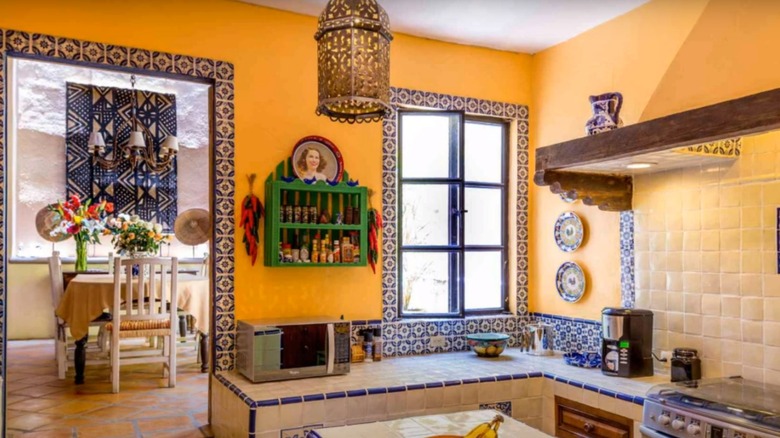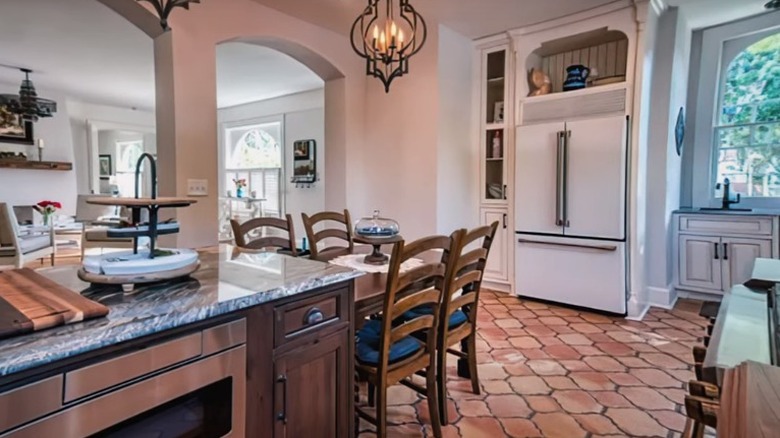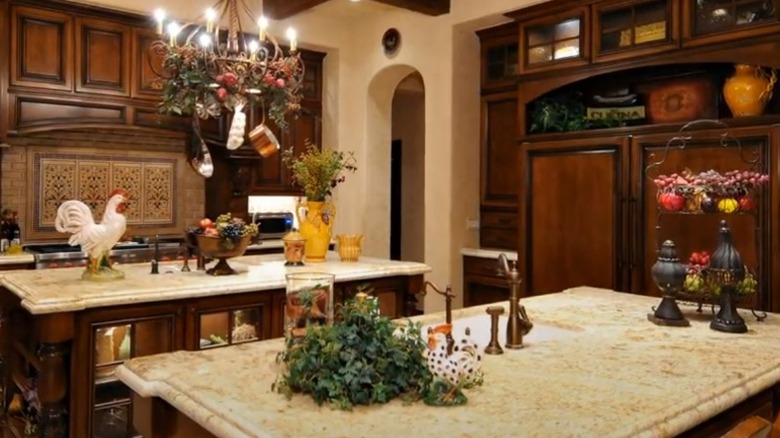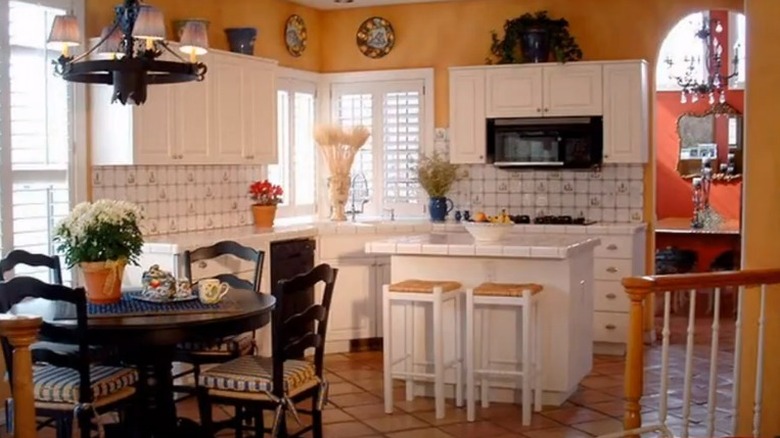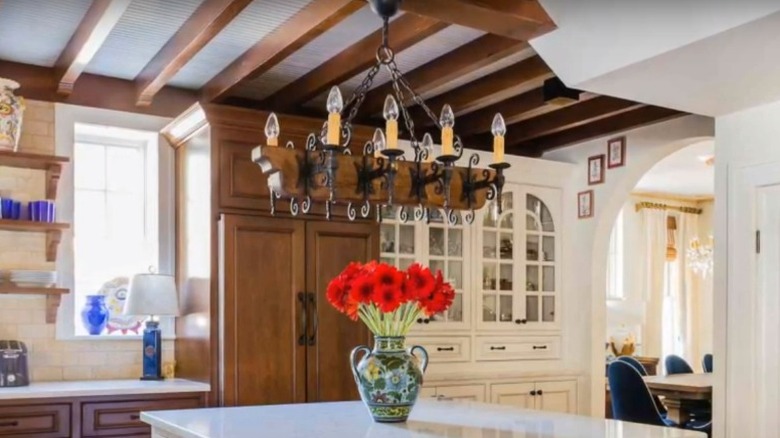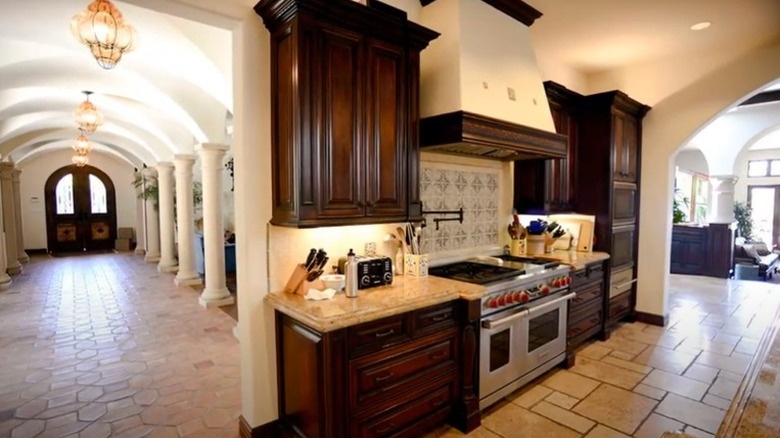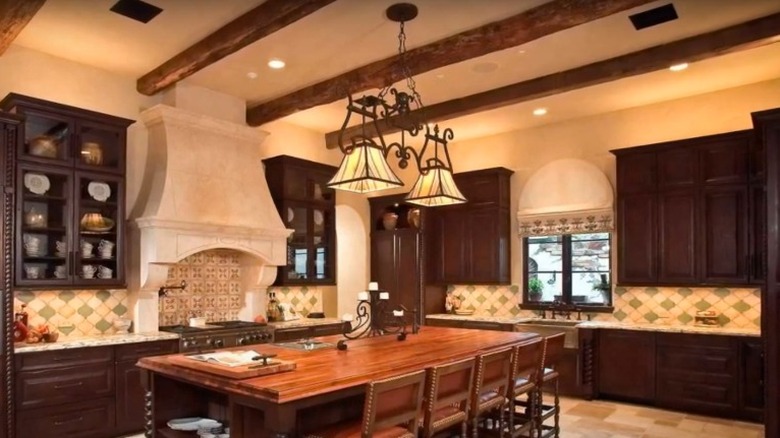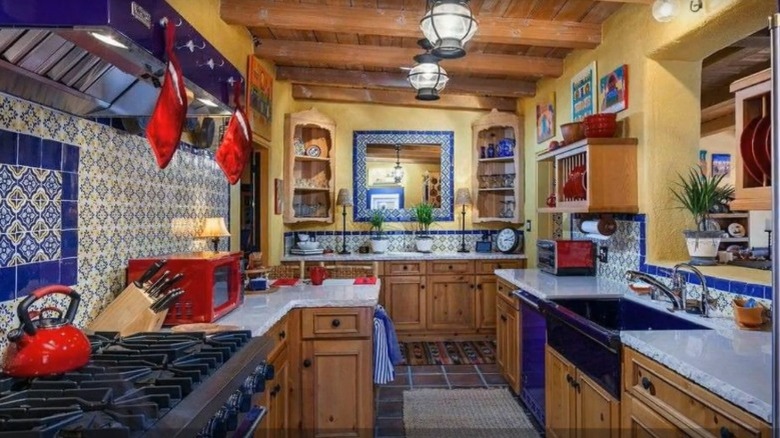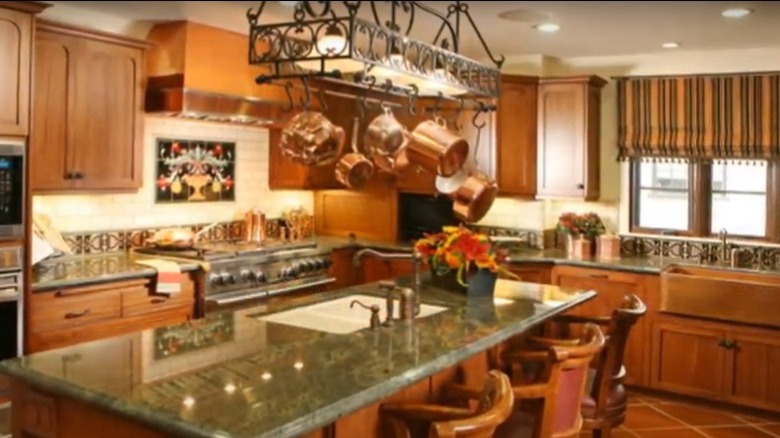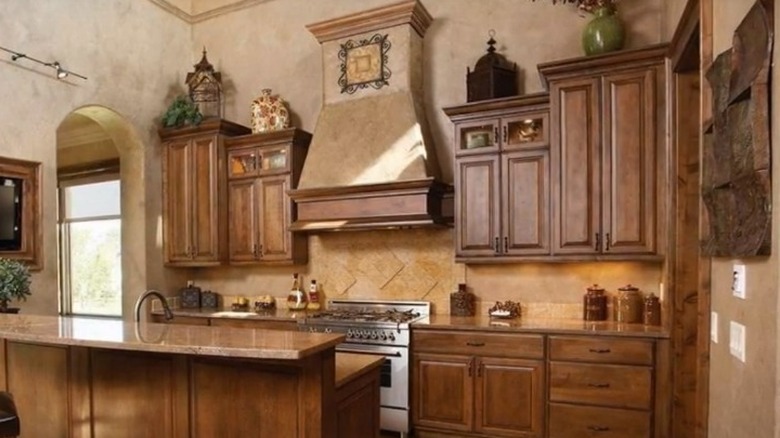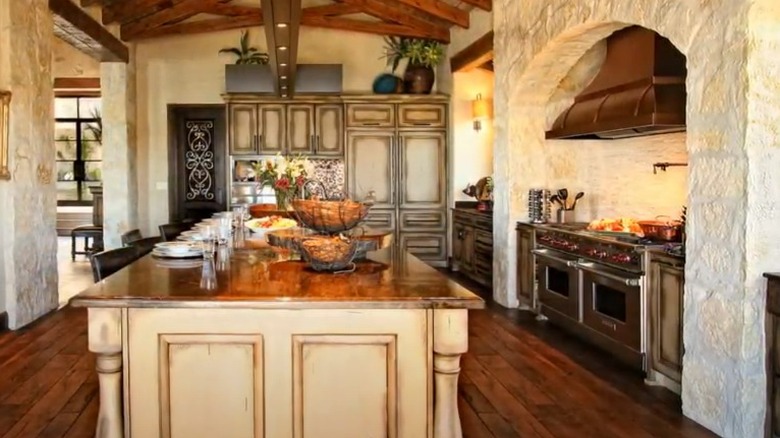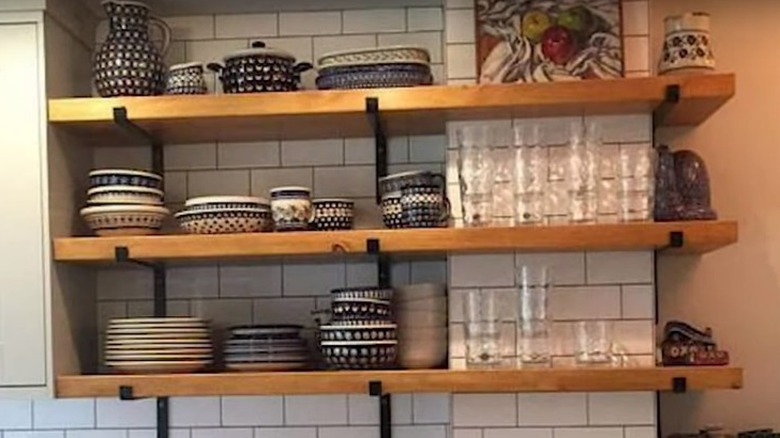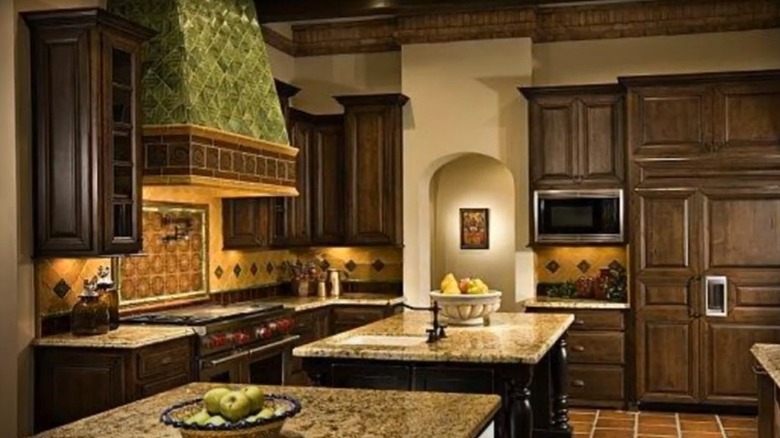How To Decorate A Spanish-Style Kitchen
Whether your kitchen is contemporary or traditional, you can give it a gorgeous makeover by embracing Spanish-style design. The first thing you need to know about how to decorate a Spanish-style kitchen is that bright colors and dark finishes abound. Rustic touches are another essential aspect of this design style. Clay flooring and wrought iron give this look an old-school feel. It is warm and homey, inviting to your family and friends. But it also includes living finishes, like oil-rubbed bronze, and sometimes even living things, like herb gardens and hanging plants.
One of the best things about this style is there are so many contradictory aspects to it. You could choose dark maple cabinets or forego them and opt for open shelving instead. If you're looking for something completely different, you could even paint your cabinets in a teal blue color, like Style by Emily Henderson. She also opted for tile backsplashes, an essential element of a Spanish-style kitchen. Choose simple colors, patterned tiles, artistically painted or mural tiles, whatever best speaks to your personality. These will suit this design style and give your kitchen a little character.
There are many ways to introduce this style to your kitchen, depending on your preferences. You can choose one or two options or mix and match the most appealing ones.
Use Saltillo or terracotta tiles for flooring
Saltillo and terracotta tiles are two versions of the same tile type. According to Westside Tile and Stone, Saltillo tiles come from the Saltillo region of Northern Mexico and are rough-edged, unfinished clay. Because they are unfinished, it is recommended that you have them installed by a contractor to ensure your floor is appropriately sealed to avoid staining. It can be cleaned with warm water and vinegar but should only be used in warmer climates. It may freeze and crack in cold regions.
Like Saltillo, terracotta tiles are often found in warmer locations, like Southern Europe and South America (via The Nordroom). Terracotta tiles are Italian and get their name from the color of the clay they're made from. "Teracotte" means "baked earth" in Italian, and the tiles made from it have high iron content, giving them the reddish hue they're known for. Terracotta tiles can be found in shades from yellow to brown.
They work well because they help to create a warm look in your kitchen, and anywhere else you put them in your home. Because they are unglazed, they will weather over time, contributing a rustic look to your kitchen. Spanish and Mediterranean homes are known for their warm, rustic feel and open-style kitchens where friends and family can gather and are encouraged to linger over meals and conversations. Choosing these tiles in your home says as much about who you are and how you choose to live as it does about how you decorate.
Choose oil-rubbed bronze finishes
Oil-rubbed bronze works well in Spanish-Style kitchens because it complements its most common colors. For instance, the reds, yellows, and browns found in terracotta and Saltillo tiles work well with oil-rubbed bronze. And like the tiles, these fixtures look worn and aged, unfinished in a way that makes them appear timeless. It also pairs well regardless of the colors you've chosen for your kitchen. This finish can add a contrasting point of interest with mild palettes and neutral tones. According to Moen, this finish works well with whites, grays, and taupes. But don't fret if your kitchen features blues, greens, and other cool colors. Oil-rubbed bronze can add a needed pop of warmth in spaces featuring these colors.
Unlike other finishes typically used in kitchens and baths, oil-rubbed bronze hardware also has the benefit of resisting fingerprints. It is, however, considered a "living finish" (via Kingston Brass). That means it will continue reacting to the environment, changing the piece's color. Years of touching and using items like faucets could lead to tones of rose gold or even green where the darker finish has worn off.
One nice thing about this is that no two pieces will look alike, resulting in a completely customized item. You will want to avoid hard water when cleaning, however, as it can result in stains on the surfaces of your oil-rubbed bronze fixtures.
Paint in warm tones
Warm tones work wonders in Spanish-style kitchens. And they are becoming trendier than the all-white that once dominated this space, according to Apollo Kitchens. You may have already used Saltillo or terracotta tiles, which are warm-toned. If you have, you can build your color scheme from there.
You will need to consider the other items in your kitchen, though. Unlike other rooms in your home, you aren't starting with a blank canvas here. There are appliances, countertops, and floors to consider when selecting a wall color. It doesn't all have to be painted, though. You can combine warm paints and tiles in earthy hues to get the look you're trying to create. Or use wood and rattan furniture to notch up the room's warmth without going overboard on your wall paint.
Warm colors are so versatile that you can use one or two in your home (via Kylie M Interiors). But remember that your kitchen location will affect your paint's appearance. In north-facing rooms, your colors will appear cooler. And in south-facing ones, your colors will appear warmer. Likewise, kitchens that get eastern morning light will look exactly like they're supposed to in the morning but can add some warmth in the afternoon. On the other hand, kitchens in western light will appear warm in the morning and even warmer in the afternoons, so be careful how warm you choose to go if your kitchen gets sun in the afternoons instead of the morning.
Add wrought iron accents
There are many ways to add wrought iron to your kitchen and even more reasons you might want to. One of the easiest ways to do this is by adding wrought iron hardware to your cabinets. Evolut Design lists other ways of including this material in your kitchen as adding kitchen carts and islands featuring wrought iron, overhead lighting made of this material, or selecting kitchen canisters that use wrought iron as accents.
Tables, benches, and chairs are often available with wrought iron legs that complement your Saltillo or terracotta tiles and warm paint tones. They give a rustic look, often associated with Spanish-style kitchens. Besides being attractive, wrought iron is durable and can last for centuries. Wrought iron is also extremely low maintenance and easy to clean as well. And changing the appearance of wrought iron is as simple as applying a coat of paint.
Select dark maple cabinets
Maple cabinets make an excellent choice for your Spanish-style kitchen. You can stain them light, medium, or dark, but dark colors work best with this decorative style. You can also paint maple cabinets.
According to Kitchen Cabinet Kings, maple is more durable than birch, oak, or pine, stands up well to daily use, and is affordable. A stain will make your maple cabinets look more rustic. It will also provide a protective layer to the surface of your cabinets. However, a polyurethane finish over is still recommended, especially in water-laden areas like kitchens and bathrooms.
Maple also withstands temperature and humidity fluctuations, making it an ideal choice for a kitchen (via Home Reference). But before you invest in new maple cabinets, you should be aware it also has its limitations. Dark stains, preferred in Spanish-Style kitchens, aren't always the easiest option. They can turn out blotchy. Professional staining is recommended with darker colors. Maple cabinets also age easily, particularly when exposed to sunlight. The wood tends to yellow over time and can make your cabinets appear dated, even when they are still new.
Leave ceiling beams exposed
Exposed wood beams are a very traditional look, making them an attractive choice in your Spanish-style kitchen. They've been trendy forever, and if you favor a more modern design with Spanish elements, this feature will make your design style stand out. And no matter what design style you prefer, this design element works. Exposed wood beams are popping up even in contemporary kitchen designs.
If you don't already have wood beams on your ceiling that you can strip and stain, there are a few ways to add them. Gambrick explains that purchasing and installing actual wood beams is the first and most straightforward way. But this option is expensive and time-consuming because of the weight of the wood beams. The second option is faux wood beams, typically made of high-density polyurethane or Styrofoam, whose exterior is coated with a thin, finished wood edge.
Besides being less expensive, faux beams are easier to mount because they are lighter in weight. You also don't have to worry about other issues you might face with real wood beams, like cracking and splitting, warping, or internal matters you might not notice until it's too late.
Install painted or decorative tiles
Painted tiles might be a bit more challenging to come by unless you're decorating them yourself, but you can find them in some home goods and specialty shops. Decorative tiles, on the other hand, are available from many retailers and can make a dramatic difference in your kitchen. The most common way to use these in a Spanish-style kitchen is to install a backsplash. Statement and artisan tiles make this part of your kitchen stand out. Damla from Otto Tiles advised Ideal Home that homeowners planning a kitchen remodel "instead of choosing just one of these warm neutrals, consider combining several tonal shades instead."
Color blocking is another popular and stylish option, which involves different sections, a line or two at a time, in varying shades – yellow, orange, and white, for example. Some decorative tiles that contain patterns and designs can outshine other options, "adding visual excitement that can't be attained by other mediums such as paint or wallpaper" (via Homes to Love). Artisan tiles are another option that allows you to show your unique style in the kitchen. But they will be costlier and more challenging to locate in your preferred styles and colors.
Decorative tile is the most expensive but also the most beautiful. And the good news is that you don't need to invest in many tiles to pull off this look (via Tile Mural Store). Consider mounting a mural on an accent wall rather than tiling a whole kitchen or a full backsplash.
Hang your pots and pans
In addition to helping create a Spanish-style vibe in your kitchen, a pot rack can help save significant space in your kitchen, according to Realtor. This will save time you would otherwise spend digging around your cabinets to find the right cookware. It also puts all the items you use most often right within arm's reach. When you need a pot, just reach up and grab one.
There are, however, things to consider when picking one out. Investing in a pot rack is best if you do a lot of cooking, unless your intention is just mounting one for decorative purposes. You'll also want to consider where you're mounting your pot rack. The best location is over your kitchen island if you have one. You should avoid hanging pots over your stove. It may seem convenient to put them there, but it leaves them susceptible to grease buildup. And make sure you mount it high enough that you won't hit your head on the pots and pans while doing routine kitchen tasks.
There are many options available. Some contain shelves and other lights while also hanging your pots and pans (via Iron Accents). You can even complement the Spanish-style design of your kitchen by choosing a wrought-iron version. These work best in ceilings that are 9 feet or higher, but there are low ceiling racks available if your ceilings don't have that height.
Add a flared hood to your stove
You probably have your microwave mounted above your stove if you're a no-nonsense type. But there are no shortages of ways to jazz up this space. A flared or angled version will add style to your Spanish kitchen. They are excellent options if you want something that will extend beyond your cabinets.
If you can't afford to swap out your existing hood, you can DIY a hood cover that replicates this style. Champagne Chaos takes you through the steps to build your own angled hood cover that opens up, so you still have access to the storage cabinets you'll be covering with your flared hood. Another advantage of this design style is that it can be changed easily if you decide you want a different style.
You'll start this project by building the frame, ensuring it has a beveled edge. Use fluting trim and fill with grout, then lime wash to take the yellowish-tint out of the pieces of wood. This is a time-consuming step, so if patience isn't a virtue you possess, you may want to skip this step.
Add archways where possible
Kitchen archways may not be an easy element to add to your kitchen, but if you have the opportunity to do it, it can bring a stunning architectural feature to this part of your home. According to SemiStories, rounded door frames can help soften harsh angles and open up your space, making rooms and your home appear larger. In large areas, they can add character.
They're also great at drawing attention to items like custom cabinetry, especially if you've painted or stained it in a unique color. Pointed archways are more dramatic. You should use those in areas you really want to draw focus toward. You can use it to create an open-concept style or add flare to the entry to a cozy corner by adding an arch.
Lovely as this style is, you shouldn't embrace it with wild abandon. There are things you must consider when adding an arch. Your primary options in terms of shape are the semi-circle arch, the Gothic arch, and the soft archway (via Style by Emily Henderson). Remember that you shouldn't mix doorway styles, so if you want to add an arched entrance to your room, you will also need an arched exit. This will help the design elements appear organic rather than forced.
Use open shelves and raw wood
If you don't want to spend the money on dark maple cabinets, you could use open shelving instead. This works best in a Spanish-style home if you opt for raw, unfinished wood. In addition to being more affordable, this style could also be more practical. According to Plank and Pillow, it can create more space in your kitchen or at least give the appearance of more space.
There are many different ways you can install these. There is the traditional format against the walls. But you can also install them on glass over windows. This makes the shelves invisible, with the dishes appearing to float in space. If you can't afford to purchase and professionally install shelves, you can make them yourself (via Allisa Jacobs). You can even hang them using iron brackets, contributing to the Spanish-style theme you're trying to create.
Consider the available space and what will be stored on the shelf before deciding what size and shape to create. No matter how beautiful the piece is, if it is too big for your space or the items you're putting on it, it will not work.
Accent your kitchen with greens
Green is a fantastic color to contribute to your Spanish-style kitchen, and there are a few ways you can green things up. Chris and Dick's recommend painting your cabinets or kitchen island in one of many shades that will work with your clay floors and wrought iron. Or adding an accent wall or an alcove to your kitchen. You could even install a kitchen island that has a green base.
If painting is too time-consuming or expensive, you could invest in some plants (via The Design Tourist). Not only will this lend the green color to your kitchen, but it also has other benefits. Hanging plants, for example, can fill an eye-level void in most kitchens. And they work well for large plants that would take up too much space on counters or shelves.
Windowsill herb gardens are another excellent option. They do double duty, making things green and giving you access to all the herbs you need for cooking your next meal. Climbing plants can also help fill your kitchen space without becoming overwhelming. If they get too big or unruly, tame them with a simple trim.
